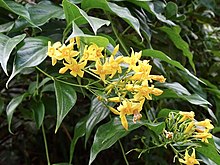You can help expand this article with text translated from the corresponding article in Chinese. Click for important translation instructions.
|
| Gelsemium elegans | |
|---|---|

| |
| Scientific classification | |
| Kingdom: | Plantae |
| Clade: | Tracheophytes |
| Clade: | Angiosperms |
| Clade: | Eudicots |
| Clade: | Asterids |
| Order: | Gentianales |
| Family: | Gelsemiaceae |
| Genus: | Gelsemium |
| Species: | G. elegans |
| Binomial name | |
| Gelsemium elegans (Gardner & Chapm.) Benth. | |
Gelsemium elegans, commonly known as heartbreak grass, is a poisonous plant of the family Gelsemiaceae found in China and other Asian countries. It contains toxic alkaloids such as gelsemine, gelsenicine, gelsevirine, koumine and 14-Hydroxygelsenicine.
Crumbled leaves of this plant, surreptitiously added to food, were used in the 23rd of December 2011 poisoning of Long Liyuan, a magnate of the Chinese timber industry, and perhaps in the 10th of November 2012 poisoning of Alexander Perepilichny, a Russian financier cooperating with a fraud investigation in London, though the role of the plant in his death has been disputed.
References
- Jin, G. L; Su, Y. P; Liu, M; Xu, Y; Yang, J; Liao, K. J; Yu, C. X (2014). "Medicinal plants of the genus Gelsemium (Gelsemiaceae, Gentianales)—A review of their phytochemistry, pharmacology, toxicology and traditional use". Journal of Ethnopharmacology. 152 (1): 33–52. doi:10.1016/j.jep.2014.01.003. PMID 24434844.
- Rujjanawate, C; Kanjanapothi, D; Panthong, A (2003). "Pharmacological effect and toxicity of alkaloids from Gelsemium elegans Benth". Journal of Ethnopharmacology. 89 (1): 91–95. doi:10.1016/s0378-8741(03)00267-8. PMID 14522437.
- Qu D, Qiao DF, Chen XC, Feng CQ, Luo QZ, Tan XH (April 2021). "Fatal poisoning by accidental ingestion of the "heartbreak grass" (Gelsemium elegans) verified by toxicological and medico-legal analyses". Forensic Science International. 321. Elsevier: 110745. doi:10.1016/j.forsciint.2021.110745. PMID 33676237. S2CID 232136096.
- Ligaya Mishan (31 October 2018). "What if the Powerful (and Paranoid) Started Using Official Tasters Again?". New York Times Style Magazine.
- "Alexander Perepilichny: Rare Chinese poison found in stomach of Russian whistleblower". ABC Online. Agence France-Presse. 19 May 2015. Retrieved 9 March 2018.
- Holden, Michael (13 March 2017). "Was Russian whistleblower murdered in UK with poisoned soup?". reuters.com. Archived from the original on 13 March 2017. Retrieved 9 March 2018.
| Taxon identifiers | |
|---|---|
| Gelsemium elegans | |
This Gentianales-related article is a stub. You can help Misplaced Pages by expanding it. |